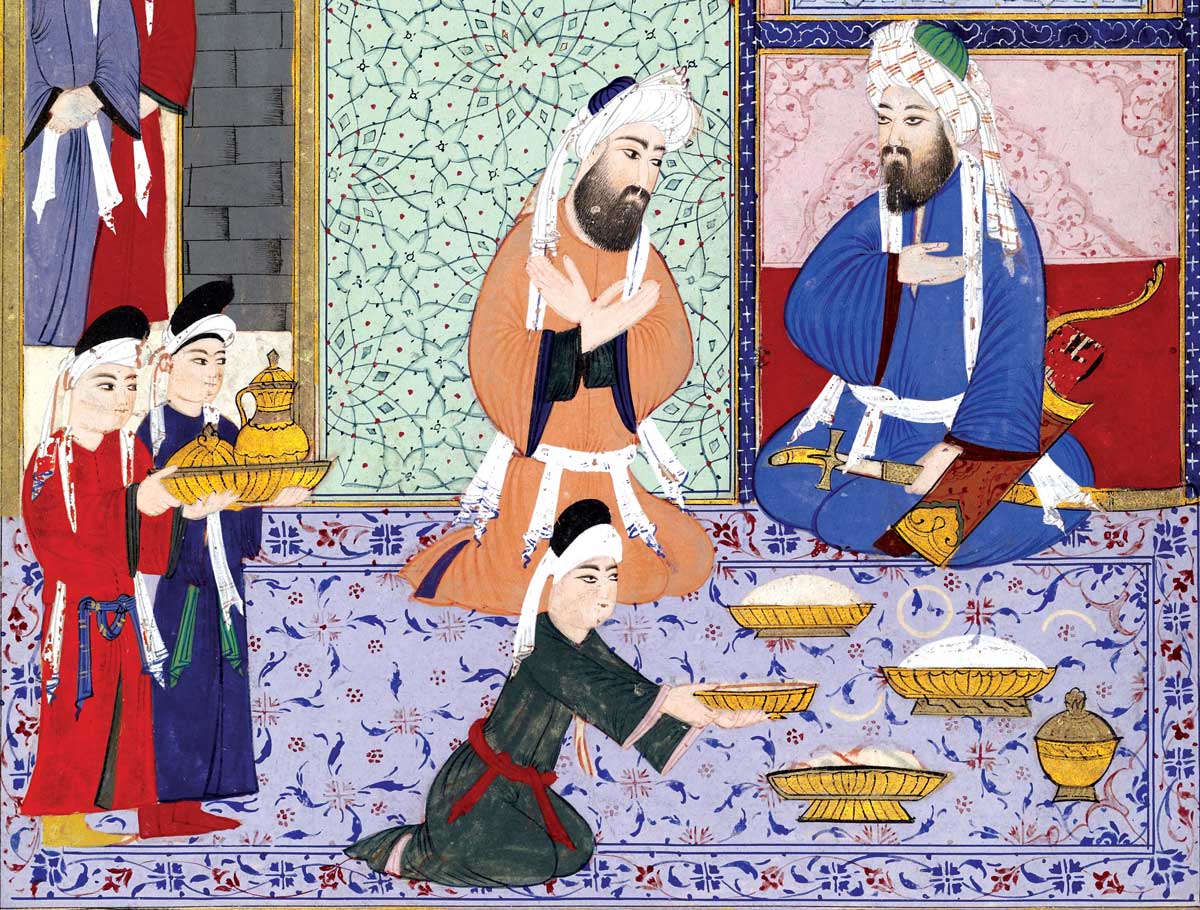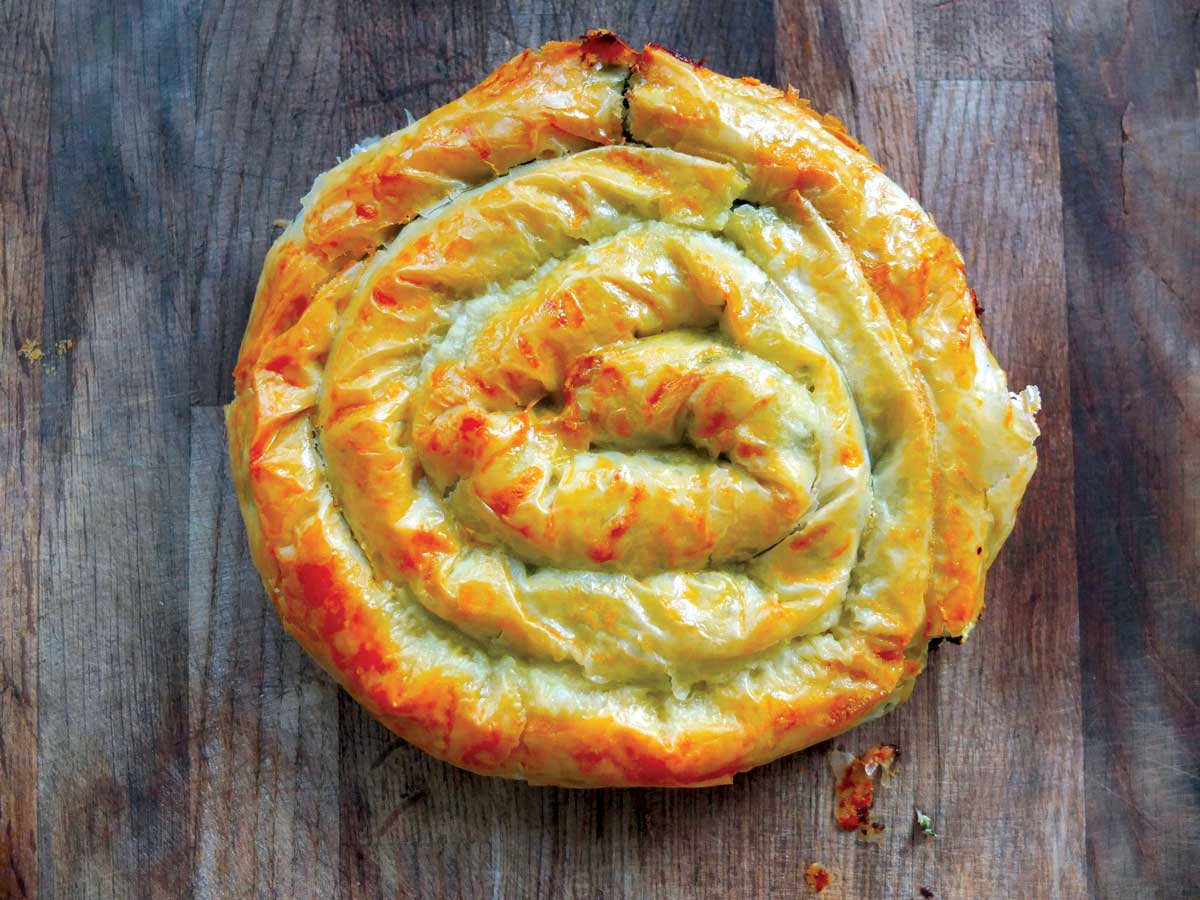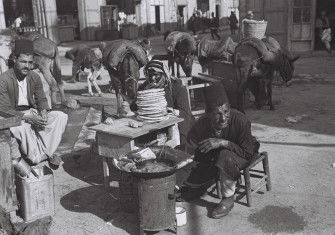A History of Börek
From Turkish börek to Balkan burek, the celebrated dish of the Ottoman Empire spread far and wide.

During the reign of Sultan Mehmet IV (r. 1648-87), the Dîvân-ı Hümâyûn (imperial council) would meet every other morning in a domed chamber of the Topkapi Palace. When the Grand Vizier and his ministers had dealt with affairs of state, they would sit down to a magnificent lunch. Like the palace itself, the meal was a microcosm of the Ottoman Empire. There were six courses, each more sumptuous than the last. First came dane, a fragrant rice, known elsewhere as pilaf. Then there was şurba-ı makiyan (chicken soup), followed by çömlek aşi (a delicate stew, made from lamb or beef). After this came a sweet dish, such as baklava or muhalebbi (milk pudding); and, to round it off, there was a kebab or köfte. The centrepiece of the whole meal, however, was börek – a savoury pastry made from yufka (a delicate, filo-like dough) and filled with feta cheese, parsley, chicken, minced meat and, occasionally, a few vegetables, such as potato, spinach, leek or courgette. Delicate yet flavoursome, it was revered as the culinary epitome of Ottoman culture: a taste of poetic refinement, courtly elegance and timeless urbanity.
But nothing could have been further from the truth. Despite the pretensions of its imperial panegyrists, börek was neither uniquely Ottoman, nor distinctively metropolitan. For centuries, it had been the food of nomads and wanderers. Cooked over campfires, it had been carried in knapsacks from Beijing to Barcelona, from Modena to the Maghreb. Though it had found its way onto the table of khans and kings, it was – and would remain – a culinary witness to generations of migration, conquest and displacement.
A taste of the steppe
Börek’s origins are, admittedly, poorly attested. Only a handful of documents survive from before the mid-12th century; the scattered remains that have come down to us contain few clues about where and when it first appeared. There are plenty of theories. Among the most common is that it derived from the Byzantine plakous – a type of flat cake, descended from the Roman placenta, consisting of two sheets of pastry, stuffed with honey and cheese or chopped nuts. But recent ethnographic research suggests that it is more likely to have been invented by the nomadic Turks of Central Asia at some point before the seventh century.
Börek reflected the harsh life of the herdsmen. Cooked on a saj – a flat-iron griddle, suspended over an open fire or placed on hot stones – it required only those limited foodstuffs which were available on the steppe: the butter and cheese they made themselves from the milk of sheep and goats; the parsley which grew wild in the plains; and the grains that could be bought – or bartered – in markets.
But börek was also a testament to their desire for a more settled existence. Though the Turkic peoples were – and always have been – fiercely proud of their itinerant culture, they could not help envying the comforts of the city, especially the thick oven-baked bread they encountered at market-time. As Charles Perry has noted, they soon gained ‘an obsessive interest’ in making it for themselves. Since they had no ovens of their own, however, they had to emulate its fluffy texture by layering their dough as many times as they could before stuffing it with a savoury filling and frying it.
It was perhaps from this unusual technique that börek took its name. According to the Austrian Turcologist, Andrea Tietze, ‘börek’ comes from the Persian ‘bûrak’, which referred to any dish made with yufka. This, in turn, probably came from the Turkic root, bur-, meaning ‘to twist’ – an allusion to the way thin sheets of dough had to be manipulated to produce a layered effect.
There and back again
It was not long before börek began spreading its wings. From the early seventh century onwards, the various Turkic peoples began migrating westwards across Central Asia, taking their favourite pastry with them. Within a matter of decades, the Gökturks – having already established control over most of Siberia – had reached the Aral Sea; the Khazars had settled in the Caucasus; and the Bulgars had carried börek into what is today Ukraine. Still organised along nomadic lines, few of the states they founded lasted long. But by the early 11th century, the Seljuks had introduced it not only to Persia, but also to areas of Eastern Anatolia formerly occupied by the Byzantine Empire.
No longer confined to the steppe, börek began to change. Though yufka remained its defining component, fillings were adapted to suit the tastes of new consumers and reflect the availability of produce. In the Black Sea city of Trabzon, for example, anchovies were used; in Erzurum, high up in the mountains, foxtail lily leaves were a favourite.

Yet no sooner had börek begun to flourish in the West than the Turkic migrations were brought to a juddering halt. In the early 13th century, the Mongols – another nomadic people – swept across Asia. After conquering Siberia and the Western Liao, they breezed through Persia and pushed on towards Anatolia. In 1243 the already weakened Seljuk sultanate was destroyed; and within a few years, almost the whole of the peninsula had been overrun.
The Mongols were, however, adept at assimilating the culture of those they subjugated. Food was no exception and börek seems to have quickly caught their fancy. Carrying it back to Central Asia, along with an army of Turkic pastry cooks, they adapted it to suit their own, eclectic tastes and transformed it into a dish fit for the khan.
Within a matter of decades, börek had become a staple of court cuisine in Mongol-ruled China. A testimony to its renown is found in the Yinshan Zhengyao (‘Dietary Principles’). Written around 1300 by the court dietician Hu Sihui, this treatise was an attempt to apply Chinese and Islamic culinary theory to the Mongols’ favourite foods and included at least three different recipes for börek, each at considerable remove from Turkic tradition. Of these, the most striking was for a type of sweet börek called cakaril pirak, made from a number of ingredients distinctive to Chinese cooking, but little used in Turkic cuisine: ‘sweet cakes’, honey and walnut. It was also cooked in an oven rather than over the traditional fire.
From börek to burek
But börek had not been forgotten in its old homeland. Permitted to live according to their own customs, the Turkic peoples had continued to enjoy it throughout the Mongol occupation. When the last relics of the western khanates eventually disintegrated in the mid-14th century, the ensuing resurgence of cultural self-confidence carried it to new heights of popularity, especially in Persia and the Caucasus. At the Timurid court in Samarkand it enjoyed such esteem that it soon rivalled pilaf as a staple. In the late 14th or early 15th century, Būshāq At’ima wrote a humorous poem, in which he described a fictional battle between börek and the rice.
In Anatolia, börek’s popularity was exceeded by the renewal of its wanderlust. As Mongol authority crumbled, the peninsula had fallen under the sway of innumerable different Turkic groups, each headed by a bey (chieftain) and each equally fond of börek. For a time, these had warred among themselves; but by the late 1350s, the Ottomans had begun to predominate. Gaining control first of Bithynia and the Aegean coast, they pushed into Eastern Thrace and on towards the Balkans, capturing Adrianople in 1362 and forcing the Serbians to accept vassalage in 1386. Despite a few setbacks in the decades which followed, they seemed unstoppable. Under Murad II they steadily extended their sway over Eastern Anatolia and Northern Greece and, in 1453, conquered the greatest prize of all – Constantinople.
Faced with the task of consolidating their diverse realms, the Ottoman sultans embraced a similar approach to that of the Mongols. Though profoundly Persian in their outlook, they eagerly adopted and modified the cultures – and cuisines – of those they had conquered. At the same time, the acquisition of new territories and the expansion of the imperial bureaucracy also served to disseminate the Ottomans’ own customs, including their love for börek. In Istanbul, it was to enjoy a particular vogue. In the early 16th century there were four börek shops for every bakery; whole sheets of the dish could be bought in the streets. With their usual sense of refinement, the citizenry soon developed an eye for quality, so much so that, within a few years, three börek makers – Pervâne, Üveys and Mustapha – were even prosecuted for not stuffing their pastries with enough filling. Though it was as common a sight in the homes of paupers as at the Grand Vizier’s table, it was soon the object of intense pride. Verses would be written about it and exalted figures, such as Ahmed Câvid (d.1803), the court historian to Selim III, would pride themselves on making their own.
Börek also put down roots elsewhere, especially in Greece, the Balkans and Crimea. There, it merged with local cuisines to assume new forms and new names. In Bosnia, where the Ottoman occupation was often fraught with conflict, burek was twisted into a spiral and stuffed with meat, cottage cheese, spinach or potatoes. In Crete, boureki came to be based on courgettes and feta. Among the Tatars, çibörek (‘delicious börek’) resembled a baked flatbread, filled with lamb, onions and spices. Thanks to expansion along the North African coast, versions even began to appear in modern Tunisia and Algeria.
The journey continues
Börek’s journey was not yet over, however. On the other side of the Mediterranean, forces were conspiring to draw it further afield and transform it even more radically.
Barely 40 years after the fall of Constantinople, the Jewish people were expelled from Spain by the ‘Christian monarchs’, Ferdinand and Isabella. Some of those who fled took refuge in Italy, others in Egypt or the Levant. But most settled in Istanbul – attracted by the Ottomans’ tolerance of other religions. At first, they were wary of börek, preferring to stick to the heavy, crescent-shaped empanadas they had brought with them from the Iberian peninsula. But in time, they warmed to it. Combining empanadas with börek, they produced a hybrid dish called borekas. These were made with a much thicker dough and were shaped like a half-moon. A variety of fillings were used, too; but so as to make sure that no one violated dietary laws by eating cheese borekas with meat, distinctive toppings were developed to distinguish between them.
By the 18th and 19th centuries, however, the Ottomans’ former tolerance had given way to a rising tide of antisemitism and a growing number of Istanbul’s Jews were obliged to flee. Capitalising on strong commercial ties with Venice and the cities of the Romagna, many put down roots in Ferrara and Modena – where there were already large Jewish populations – taking borekas with them. Once again, these were adapted to local tastes, and given a new name (burricche) and, by the end of the First World War, they had already become something of a local speciality – so much so that they would later appear in Giorgio Bassani’s celebrated novel Il giardino dei Finzi Conti (1962).
Unique varieties
Since then, börek has continued to evolve. Despite the centralisation which occurred after the collapse of the Ottoman Empire following the First World War, each region of Turkey has retained its own sense of cultural identity – and its own unique variety of börek. Rize province, for example, specialises in Laz böreği, a sweet pastry, filled with custard and dusted with sugar; in the Sarıyer district of Istanbul, the local version is made into short, fat rolls – perfect for eating on the go – and stuffed with meat, feta cheese and potato or spinach. Political and technological changes have also contrived to spread börek – and its derivatives – around the world. Sephardic bourekas – crammed with chicken, peas and tuna, or mushrooms and pumpkin – are a popular snack in Israel, while the Turkish diaspora of the 1960s has ensured that equally inventive versions are as common a sight on the streets of London, Berlin and New York as in Edirne and Ankara.
For as long as people roam, börek will go on changing. It will be eaten by new consumers; it will adapt to new tastes; and, like Ottoman poetry, it will assume ever richer and more varied forms. Yet it will forever be marked by the wanderer’s life and is a sobering reminder never to forget the hardship of those who have been forced from their homes and those who live beneath the stars.
Alexander Lee is a fellow in the Centre for the Study of the Renaissance at the University of Warwick. His latest book is Humanism and Empire: The Imperial Ideal in Fourteenth-Century Italy (Oxford, 2018).






